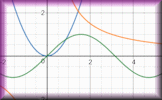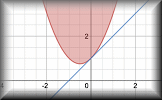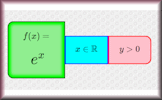Here are some specific activities, investigations or visual aids we have picked out. Click anywhere in the grey area to access the resource.
 Graph Equation Pairs Match the equation with its graph. Includes quadratics, cubics, reciprocals, exponential and the sine function.
Graph Equation Pairs Match the equation with its graph. Includes quadratics, cubics, reciprocals, exponential and the sine function. Graph Plotter An online tool to draw, display and investigate graphs of many different kinds.
Graph Plotter An online tool to draw, display and investigate graphs of many different kinds. Domain, Range and Asymptotes Match the functions with their features. A drag and drop activity.
Domain, Range and Asymptotes Match the functions with their features. A drag and drop activity.
Here are some exam-style questions on this statement:
- "(a) Sketch the graph of \( y = f(x) \) for values of \( x \) between \(-5\) and \(5\) given that:" ... more
- "The function \( f \) is defined by \( f(x) = \frac{5x + 5}{3x - 6} \) for \( x \in \mathbb{R}, x \neq 2 \)." ... more
- "A function \(f\) is defined by \(f(x) = 2 + \dfrac{1}{3-x}, \text{ where } x \in \mathbb{R}, x \neq 3.\)" ... more
- "Let \(f(x)=\frac{3x}{x-q}\), where \(x \neq q\)." ... more
- "Let \(f(x) = \frac{9x-3}{bx+9}\) for \(x \neq -\frac9b, b \neq 0\)." ... more
Here is an Advanced Starter on this statement:
Click on a topic below for suggested lesson Starters, resources and activities from Transum.
Furthermore
Rational functions of the form \( f(x) = \frac{ax + b}{cx + d} \), where \( a, b, c, \) and \( d \) are constants and \( cx + d \neq 0 \), exhibit interesting behaviors on their graphs. These functions can have both vertical and horizontal asymptotes, which are lines that the graph approaches but never touches.
Vertical asymptotes occur where the denominator of the function is zero. For the given form, the vertical asymptote is at \( x = -\frac{d}{c} \), provided \( c \neq 0 \). Horizontal asymptotes, on the other hand, are determined by the degrees of the numerator and the denominator. If the degree of the numerator is less than the degree of the denominator, the horizontal asymptote is the x-axis, or \( y = 0 \). If the degrees are equal, the horizontal asymptote is \( y = \frac{a}{c} \).
Key Formulae:
- Vertical Asymptote: \( x = -\frac{d}{c} \) (if \( c \neq 0 \))
- Horizontal Asymptote: \( y = 0 \) if degree of numerator < degree of denominator; \( y = \frac{a}{c} \) if degrees are equal
Example:
Consider the function \( f(x) = \frac{2x + 3}{x - 1} \). The vertical asymptote is at \( x = 1 \) (since \( x - 1 = 0 \) at \( x = 1 \)), and the horizontal asymptote is \( y = \frac{2}{1} = 2 \) since the degrees of the numerator and denominator are equal.
The graph of this function approaches but does not touch the lines \( x = 1 \) and \( y = 2 \), illustrating the properties of its asymptotes.
If you use a TI-Nspire GDC there are instructions for finding asymptotes.
This video on Rational Functions, Asymptotes and Graphs is from Revision Village and is aimed at students taking the IB Maths Standard level course.
How do you teach this topic? Do you have any tips or suggestions for other teachers? It is always useful to receive feedback and helps make these free resources even more useful for Maths teachers anywhere in the world. Click here to enter your comments.

